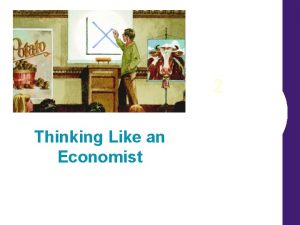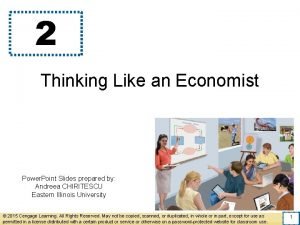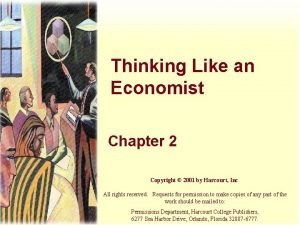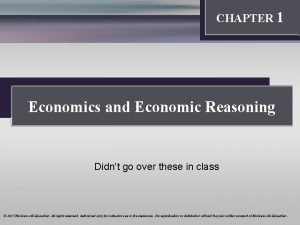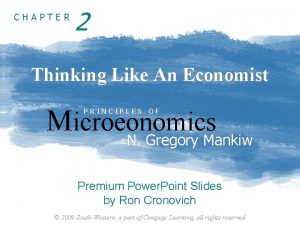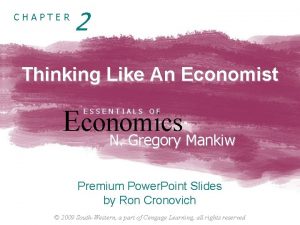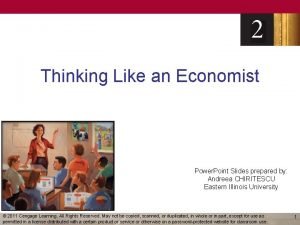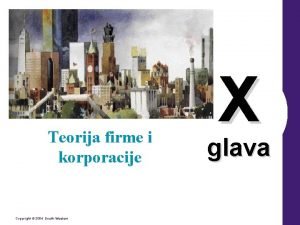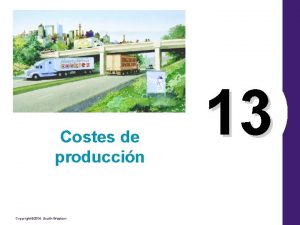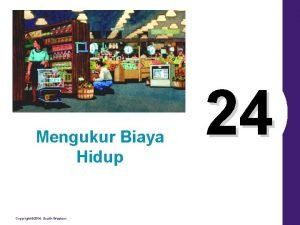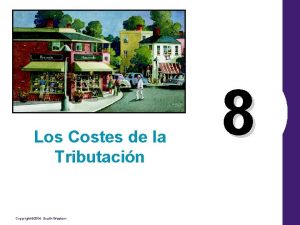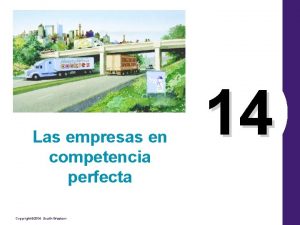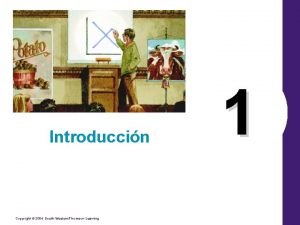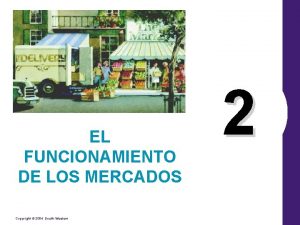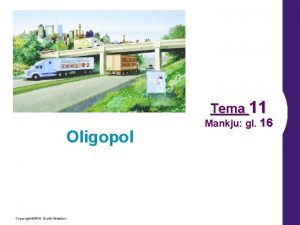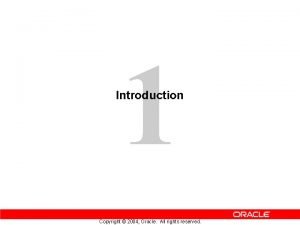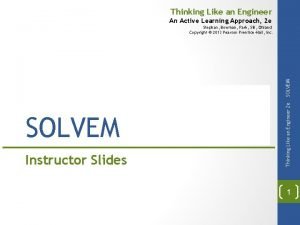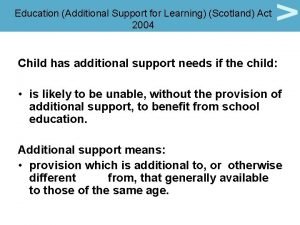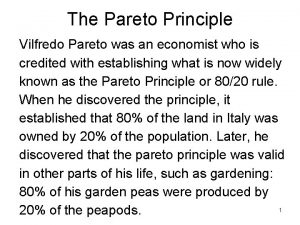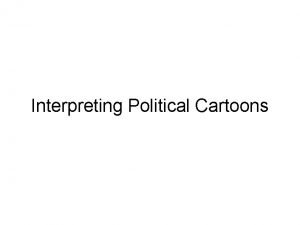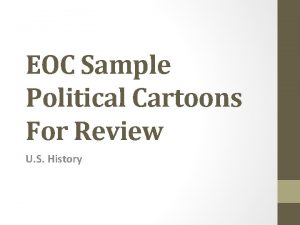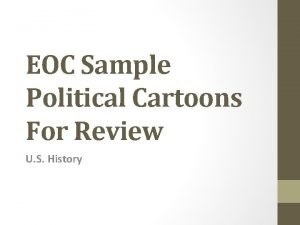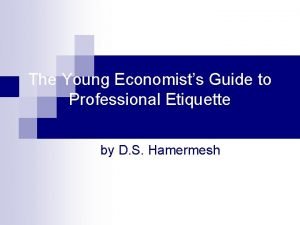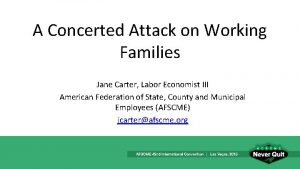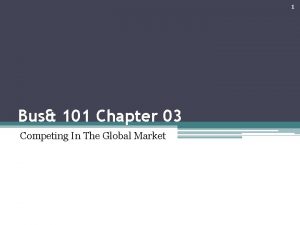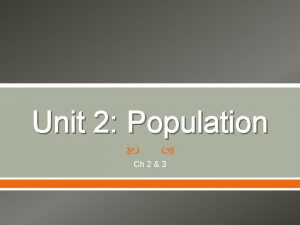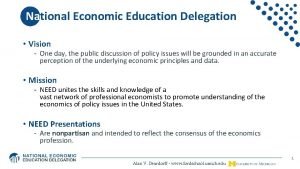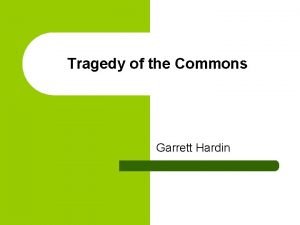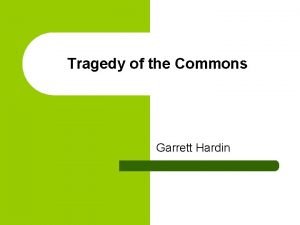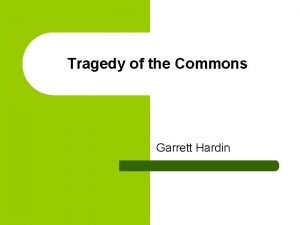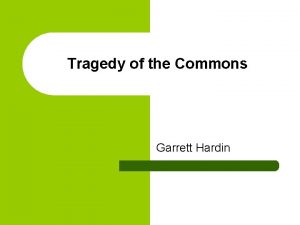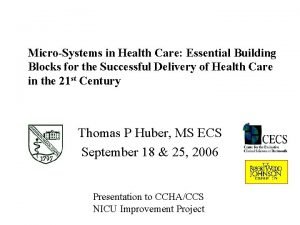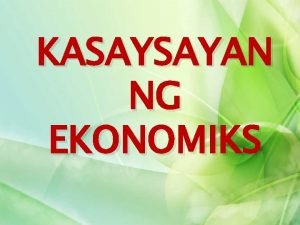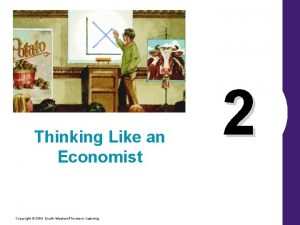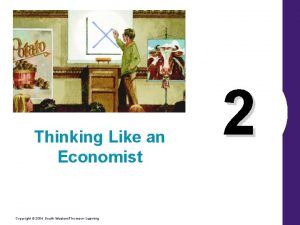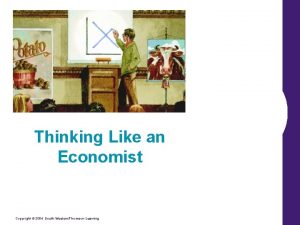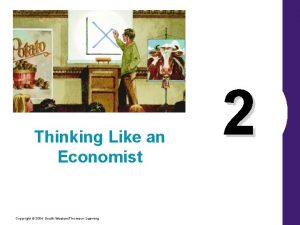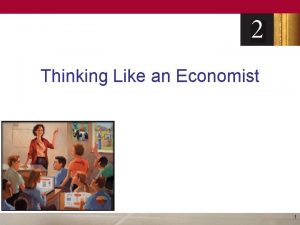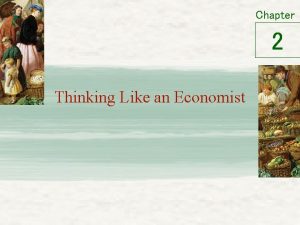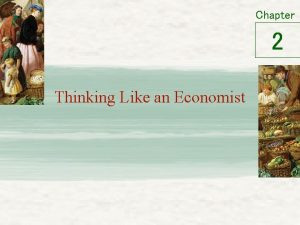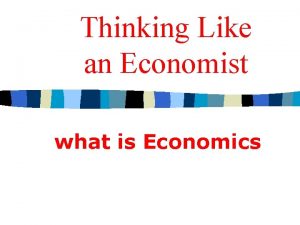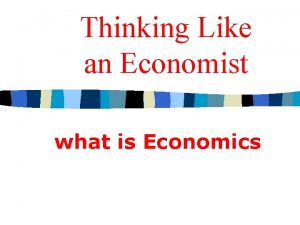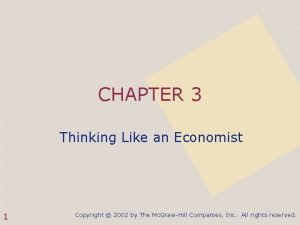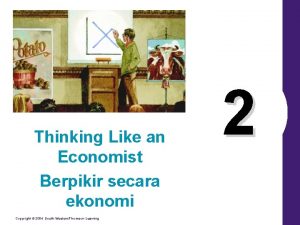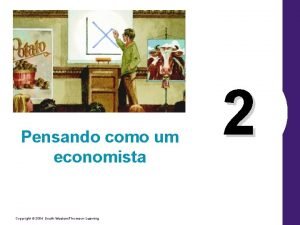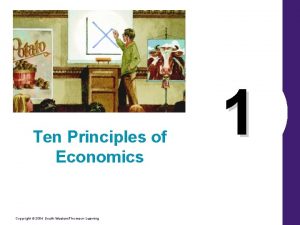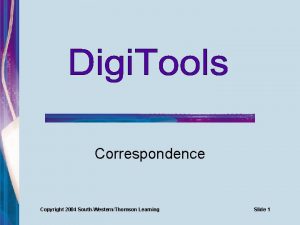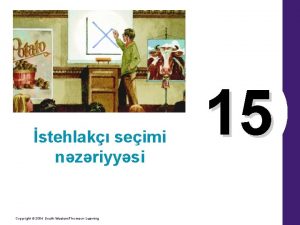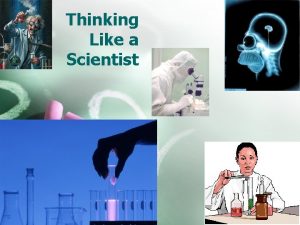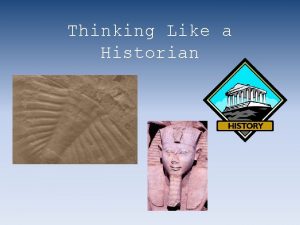Thinking Like an Economist Copyright 2004 SouthWesternThomson Learning





































- Slides: 37

Thinking Like an Economist Copyright © 2004 South-Western/Thomson Learning 2

Thinking Like an Economist • Every field of study has its own terminology • Mathematics • integrals axioms vector spaces • Psychology • ego id cognitive dissonance • Law • promissory estoppel torts venues • Economics • supply opportunity cost elasticity consumer surplus demand comparative advantage deadweight loss Copyright © 2004 South-Western/Thomson Learning

Thinking Like an Economist • Economics trains you to. . • Think in terms of alternatives. • Evaluate the cost of individual and social choices. • Examine and understand how certain events and issues are related. Copyright © 2004 South-Western/Thomson Learning

THE ECONOMIST AS A SCIENTIST • The economic way of thinking. . . • Involves thinking analytically and objectively. • Makes use of the scientific method. Copyright © 2004 South-Western/Thomson Learning

The Scientific Method: Observation, Theory, and More Observation • Uses abstract models to help explain how a complex, real world operates. • Develops theories, collects, and analyzes data to evaluate theories. Copyright © 2004 South-Western/Thomson Learning

The Role of Assumptions • Economists make assumptions in order to make the world easier to understand. • The art in scientific thinking is deciding which assumptions to make. • Economists use different assumptions to answer different questions. Copyright © 2004 South-Western/Thomson Learning

Economic Models • Economists use models to simplify reality in order to improve our understanding of the world • Copyright © 2004 South-Western/Thomson Learning

Model Building • A model is a theoretical construct that represents economic processes by a set of variables and a set of logical and/or quantitative relationships between them. • It is a simplified framework designed to illustrate complex processes, often but not always using mathematical techniques. • Frequently, economic models use structural parameters. Structural parameters are underlying parameters in a model or class of models. A model may have various parameters and those parameters may change to create various properties. 8 Copyright © 2004 South-Western/Thomson Learning

Model Building (Cont‘d) • A model is simpler than the reality it represents. What a model includes and what it leaves out result from assumptions about what is essential and what are inessential details. • The art in scientific thinking is deciding which assumptions to make. • Economists use different assumptions to answer different questions. 9 Copyright © 2004 South-Western/Thomson Learning

Model Building (Cont‘d) • You can see how ignoring some details is useful – even essential – to our understanding by thinking about a model that we use very often: A map! 10 Copyright © 2004 South-Western/Thomson Learning

London Tourist Map 11 Copyright © 2004 South-Western/Thomson Learning

London Postcode Map 12 Copyright © 2004 South-Western/Thomson Learning

London Tube Map 13 Copyright © 2004 South-Western/Thomson Learning

London Street Map 14 Copyright © 2004 South-Western/Thomson Learning

Two of the most basic economic models include: The Circular Flow Diagram The Production Possibilities Frontier Copyright © 2004 South-Western/Thomson Learning

Our First Model: The Circular-Flow Diagram • The circular-flow diagram is a visual model of the economy that shows how dollars flow through markets among households and firms. Copyright © 2004 South-Western/Thomson Learning

Figure 1 The Circular Flow MARKETS FOR GOODS AND SERVICES • Firms sell Goods • Households buy and services sold Revenue Wages, rent, and profit Goods and services bought HOUSEHOLDS • Buy and consume goods and services • Own and sell factors of production FIRMS • Produce and sell goods and services • Hire and use factors of production Factors of production Spending MARKETS FOR FACTORS OF PRODUCTION • Households sell • Firms buy Labor, land, and capital Income = Flow of inputs and outputs = Flow of dollars Copyright © 2004 South-Western

Our First Model: The Circular-Flow Diagram • Firms • Produce and sell goods and services • Hire and use factors of production • Households • Buy and consume goods and services • Own and sell factors of production Copyright © 2004 South-Western/Thomson Learning

Our First Model: The Circular-Flow Diagram • Markets for Goods and Services • Firms sell • Households buy • Markets for Factors of Production • Households sell • Firms buy Copyright © 2004 South-Western/Thomson Learning

Our First Model: The Circular-Flow Diagram • Factors of Production • Inputs used to produce goods and services • Land, labor, and capital Copyright © 2004 South-Western/Thomson Learning

Our Second Model: The Production Possibilities Frontier • The production possibilities frontier is a graph that shows the combinations of output that the economy can possibly produce given the available factors of production and the available production technology. Copyright © 2004 South-Western/Thomson Learning

Figure 2 The Production Possibilities Frontier Quantity of Computers Produced 3, 000 D C 2, 200 2, 000 A Production possibilities frontier B 1, 000 0 300 600 700 1, 000 Quantity of Cars Produced Copyright© 2003 Southwestern/Thomson Learning

Our Second Model: The Production Possibilities Frontier • Concepts Illustrated by the Production Possibilities Frontier • • Efficiency Tradeoffs Opportunity Cost Economic Growth Copyright © 2004 South-Western/Thomson Learning

Figure 3 A Shift in the Production Possibilities Frontier Quantity of Computers Produced 4, 000 3, 000 2, 100 2, 000 0 E A 700 750 1, 000 Quantity of Cars Produced Copyright © 2004 South-Western

Microeconomics and Macroeconomics • Microeconomics focuses on the individual parts of the economy. • How households and firms make decisions and how they interact in specific markets • Macroeconomics looks at the economy as a whole. • Economy-wide phenomena, including inflation, unemployment, and economic growth Copyright © 2004 South-Western/Thomson Learning

THE ECONOMIST AS POLICY ADVISOR • When economists are trying to explain the world, they are scientists. • When economists are trying to change the world, they are policy advisor. Copyright © 2004 South-Western/Thomson Learning

POSITIVE VERSUS NORMATIVE ANALYSIS • Positive statements are statements that attempt to describe the world as it is. • Called descriptive analysis • Normative statements are statements about how the world should be. • Called prescriptive analysis Copyright © 2004 South-Western/Thomson Learning

POSITIVE VERSUS NORMATIVE ANALYSIS • Positive or Normative Statements? ? ? • An increase in the minimum wage will cause a decrease in employment among the least-skilled. POSITIVE • Higher federal budget deficits will cause interest rates to increase. POSITIVE ? Copyright © 2004 South-Western/Thomson Learning

POSITIVE VERSUS NORMATIVE ANALYSIS • Positive or Normative Statements? ? ? • The income gains from a higher minimum wage are worth more than any slight reductions in employment. NORMATIVE • State governments should be allowed to collect from tobacco companies the costs of treating smoking-related illnesses among the poor. NORMATIVE ? Copyright © 2004 South-Western/Thomson Learning

Economists in Washington • . . . serve as advisers in the policymaking process of the three branches of government: • Legislative • Executive • Judicial Copyright © 2004 South-Western/Thomson Learning

Economists in Washington • Some government agencies that collect economic data and make economic policy: • Department of Commerce • http: //www. commerce. gov • Bureau of Labor Statistics • http: //www. bls. gov • Congressional Budget Office • http: //www. cbo. gov • Federal Reserve Board • http: //www. federalreserve. gov Copyright © 2004 South-Western/Thomson Learning

WHY ECONOMISTS DISAGREE • They may disagree about the validity of alternative positive theories about how the world works. • They may have different values and, therefore, different normative views about what policy should try to accomplish. Copyright © 2004 South-Western/Thomson Learning

Table 2 Ten Propositions about Which Most Economists Agree Copyright © 2004 South-Western

Summary • Economists try to address their subjects with a scientist’s objectivity. • They make appropriate assumptions and build simplified models in order to understand the world around them. • Two simple economic models are the circular-flow diagram and the production possibilities frontier. Copyright © 2004 South-Western/Thomson Learning

Summary • Economics is divided into two subfields: • Microeconomists study decisionmaking by households and firms in the marketplace. • Macroeconomists study the forces and trends that affect the economy as a whole Copyright © 2004 South-Western/Thomson Learning

Summary • A positive statement is an assertion about how the world is. • A normative statement is an assertion about how the world ought to be. • When economists make normative statements, they are acting more as policy advisors than scientists. Copyright © 2004 South-Western/Thomson Learning

Summary • Economists who advise policymakers offer conflicting advice either because of differences in scientific judgments or because of differences in values. • At other times, economists are united in the advice they offer, but policymakers may choose to ignore it. Copyright © 2004 South-Western/Thomson Learning
 Thinking like an economist summary
Thinking like an economist summary Thinking like an economist ppt
Thinking like an economist ppt Thinking like an economist chapter 2
Thinking like an economist chapter 2 Thinking like an economist chapter 1
Thinking like an economist chapter 1 Chapter 2 thinking like an economist
Chapter 2 thinking like an economist Chapter 2 thinking like an economist summary
Chapter 2 thinking like an economist summary Thinking like an economist chapter 2
Thinking like an economist chapter 2 Copyright 2004
Copyright 2004 Ejemplos de bienes publicos
Ejemplos de bienes publicos Copyright 2004
Copyright 2004 Konsep biaya hidup
Konsep biaya hidup Copyright 2004
Copyright 2004 Copyright 2004
Copyright 2004 Copyright 2004
Copyright 2004 Copyright 2004
Copyright 2004 Nesova ravnoteza
Nesova ravnoteza Copyright 2004
Copyright 2004 Copyright 2004
Copyright 2004 Copyright 2004
Copyright 2004 Thinking like an engineer: an active learning approach
Thinking like an engineer: an active learning approach Additional support for learning act 2004
Additional support for learning act 2004 Lower inner fence
Lower inner fence A wise economist asks a question analysis
A wise economist asks a question analysis This 1924 cartoon satirizes a scandal that led to
This 1924 cartoon satirizes a scandal that led to What does the cartoon imply about the open door policy
What does the cartoon imply about the open door policy The young economist's guide to professional etiquette
The young economist's guide to professional etiquette Jane carter labor economist
Jane carter labor economist Economist.com
Economist.com Economist.com
Economist.com Economist china trade
Economist china trade Examples of tragedy of the commons
Examples of tragedy of the commons Meaning of tragedy of the commons
Meaning of tragedy of the commons Hardin economist
Hardin economist Hardin economist
Hardin economist The economist
The economist Ama ng ekonomiks
Ama ng ekonomiks Cuadro comparativo e-learning b-learning m-learning
Cuadro comparativo e-learning b-learning m-learning Positive thinking vs negative thinking examples
Positive thinking vs negative thinking examples
